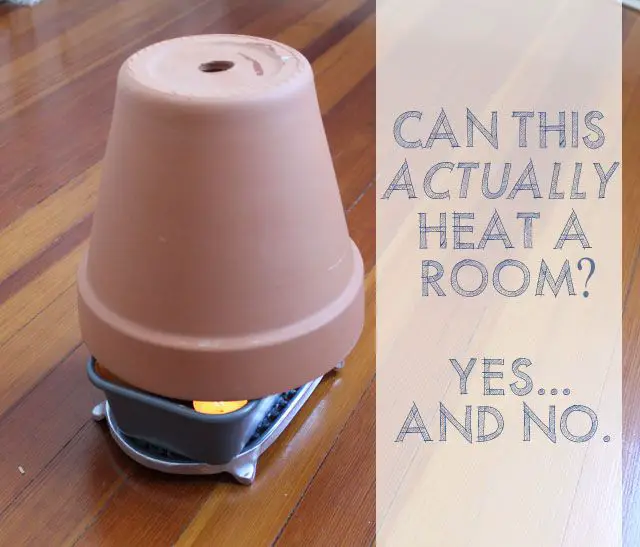A terracotta pot produces radiant heat which can help warm up a room to some extent. The pot absorbs heat from sunlight or another heat source and then slowly releases that warmth over time. While a single terracotta pot likely won’t heat an entire room sufficiently, using multiple pots strategically placed around a room can provide supplemental heat and raise the overall temperature.
Page Contents
How Does a Terracotta Pot Produce Heat?
Terracotta is an earthenware clay that is fired at high temperatures. It has properties that enable it to absorb, store, and slowly release heat energy. Specifically:
- Terracotta has low thermal conductivity, meaning it conducts heat slowly. This allows it to retain heat effectively.
- It has high heat capacity, allowing it to absorb a lot of heat.
- Its porous structure gives it a large surface area for heat transfer.
When a terracotta pot is heated by an external source, such as the sun or a candle, it soaks up that heat energy and traps it within all the nooks and crannies of its porous clay. The terracotta then emits gentle radiant warmth over an extended period of time.
Heating Methods
There are a few different ways you can heat up a terracotta pot to provide supplemental heat:
Sunlight
Placing terracotta pots in sunny windows allows them to absorb free solar energy during the daytime. The pots will heat up gradually and then radiate that warmth later into the evening. Rotate the pots occasionally so all sides absorb sunlight.
Candles or Flame
Lighting a candle or oil lamp beneath a terracotta pot causes the flame’s heat to be absorbed. The pot then emits this warmth slowly over several hours. Use caution to position the flame safely.
Electric Heating
You can place a low-wattage electric heating pad, hot plate, or other heat source beneath or inside a terracotta pot. This transfers heat efficiently into the terracotta. Take precautions against overheating.
Warm Light Bulbs
An incandescent or halogen light bulb positioned near or touching a terracotta pot will transfer radiant warmth. The pot absorbs and later releases this heat.
Placement for Heating a Room
To maximize the heat output from terracotta pots for warming a room:
- Use multiple pots around the room, preferably a minimum of 4-5 pots.
- Position pots near seating areas, beds, or where people gather.
- Locate pots out in the open, not blocked by furniture.
- Place pots on heat-safe surfaces and away from flammable materials.
- Group pots together to combine their radiating heat.
Distributing several pots around different parts of a room helps spread gentle warmth throughout the space. The more pots used, the greater the heating effect.
Tips for Heating Effectiveness
To maximize the heating ability of terracotta pots:
- Choose unglazed clay pots which absorb and release heat better than glazed.
- Opt for thicker, denser pots rather than thin, porous ones.
- Look for terracotta with a dark color which absorbs heat better.
- Use broad, shallow pots with more surface area.
- Add insulation like crumpled newspaper below the pot to retain heat.
- Place pots on a heat-conducting surface like brick or stone.
Proper positioning is also important. Keep pots out in the open and elevated if possible. Direct contact with the heat source maximizes energy transfer.
Temperature Output
A single terracotta pot will radiate gentle warmth in a limited radius. The size of pot and heating method impacts exact temperatures:
| Pot Size | Heating Method | Approximate Temperature |
|---|---|---|
| Small (4″ diameter) | Tealight candle | 90°F within 6 inches |
| Medium (6″ diameter) | 40W bulb | 105°F within 1 foot |
| Large (10″ diameter) | Sunlight (3 hours) | 85°F within 2 feet |
Grouping multiple pots boosts temperatures. With 4-5 medium pots heated by 40W bulbs, you can achieve 70°F within a 150 square foot area.
Insulating a Room
While terracotta pots produce supplemental heat, retention depends heavily on insulation:
- Seal drafts from doors, windows, vents, and any gaps.
- Close curtains and blinds at night.
- Ensure walls and attic space have adequate insulation.
- Use rugs on floors and wall hangings to retain heat.
Without proper insulation, any warmth generated by the pots will quickly dissipate. Insulation helps retain the heat within the room.
Fire Safety
When heating terracotta pots:
- Never leave open flames like candles unattended.
- Keep pots on non-flammable surfaces, not wood or carpets.
- Ensure adequate ventilation and airflow around pots.
- Check pots regularly to avoid overheating or fire risks.
- Keep pets and children away from hot pots.
Use extreme care when using flames or electric heating sources. Place pots securely out of reach and supervise closely to prevent fire hazards.
Other Considerations
A few other things to keep in mind when using terracotta pots for heating:
- Heating effectiveness depends on climate. Colder areas will see greater impact.
- Pots mainly provide short-term, localized warmth, not whole room heating.
- The quantity of pots needed may be impractical for heating larger spaces.
- Fuel sources like candles or electricity can become costly long-term.
- Heated pots dry out the air, requiring humidification.
While terracotta pots can take the chill off and provide some extra comfort, have realistic expectations about their heating capabilities. They work best for small, insulated spaces.
Conclusion
Terracotta pots can indeed provide gentle, radiating heat to help warm a room. Their effectiveness depends on several factors:
– Using enough pots strategically placed around the room.
– Maximizing heat absorption and transfer into the pots.
– Retaining heat with good insulation.
– Safe operation and monitoring of heat sources.
With careful setup following fire safety precautions, terracotta pots work reasonably well at boosting temperatures in a small room or area. However, they may not sufficiently heat an entire room alone. Combine terracotta heating with proper insulation and supplemental warmth from other sources for best results.
